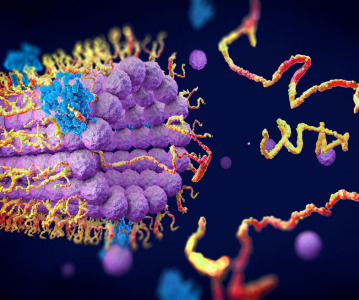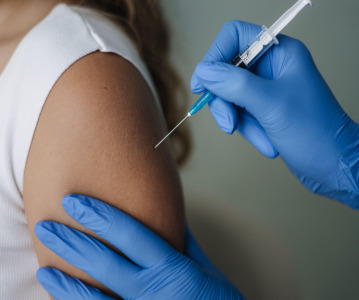New Non-Invasive Technique Controls the Size of Molecules Penetrating the Blood-Brain Barrier

A new technique developed by Elisa Konofagou, professor of biomedical engineering and radiology at Columbia Engineering, has demonstrated for the first time that the size of molecules penetrating the blood-brain barrier (BBB) can be controlled using acoustic pressure — the pressure of an ultrasound beam — to let specific molecules through. The study was published in the July issue of the Journal of Cerebral Blood Flow & Metabolism.
“This is an important breakthrough in getting drugs delivered to specific parts of the brain precisely, non-invasively, and safely, and may help in the treatment of central nervous system diseases like Parkinson’s and Alzheimer’s,” says Konofagou, whose National Institutes of Health Research Project Grant (R01) funding was just renewed for another four years for an additional $2.22 million. The award is for research to determine the role of the microbubble in controlling both the efficacy and safety of drug safety through the BBB with a specific application for treating Parkinson’s disease.
Most small — and all large — molecule drugs do not currently penetrate the BBB that sits between the vascular bed and the brain tissue. “As a result,” Konofagou explains, “all central nervous system diseases remain undertreated at best. For example, we know that Parkinson’s disease would benefit by delivery of therapeutic molecules to the neurons so as to impede their slow death. But because of the virtually impermeable barrier, these drugs can only reach the brain through direct injection and that requires anesthesia and drilling the skull while also increasing the risk of infection and limiting the number of sites of injection. And transcranial injections rarely work — only about one in ten is successful.”
Focused ultrasound in conjunction with microbubbles — gas-filled bubbles coated by protein or lipid shells — continues to be the only technique that can permeate the BBB safely and non-invasively. When microbubbles are hit by an ultrasound beam, they start oscillating and, depending on the magnitude of the pressure, continue oscillating or collapse. While researchers have found that focused ultrasound in combination with microbubble cavitation can be successfully used in the delivery of therapeutic drugs across the BBB, almost all earlier studies have been limited to one specific-sized agent that is commercially available and widely used clinically as ultrasound contrast agents. Konofagou and her team were convinced there was a way to induce a size-controllable BBB opening, enabling a more effective method to improve localised brain drug delivery.
Konofagou targeted the hippocampus, the memory center of the brain, and administered different-sized sugar molecules (Dextran). She found that higher acoustic pressures led to larger molecules accumulating into the hippocampus as confirmed by fluorescence imaging. This demonstrated that the pressure of the ultrasound beam can be adjusted depending on the size of the drug that needs to be delivered to the brain: all molecules of variant sizes were able to penetrate the opened barrier but at distinct pressures; that is, small molecules at lower pressures and larger molecules at higher pressures.
“Through this study, we’ve been able to show, for the first time, that we can control the BBB opening size through the use of acoustic pressure,” says Konofagou. “We’ve also learned much more about the physical mechanisms associated with the trans-BBB delivery of different-sized agents, and understanding the BBB mechanisms will help us to develop agent size-specific focused ultrasound treatment protocols.”
Konofagou and her Ultrasound Elasticity Imaging Laboratory team plan to continue to work on the treatment of Alzheimer’s and Parkinson’s in a range of models, and hope to test their technique in clinical trials within the next 5 years.
“It is frightening to think that in the 21st century we still have no idea how to treat most brain diseases,” Konofagou adds. “But we’re really excited because we now have a tool that could potentially change the current dire predictions that come with a neurological disorder diagnosis.”
Related News
-
News A Day in the Life of a Start-Up Founder and CEO
At CPHI we work to support Start-Up companies in the pharmaceutical industry and recognise the expertise and innovative angles they bring to the field. Through our Start-Up Programme we have gotten to know some of these leaders, and in this Day in the ... -
News Biopharmaceutical manufacturing boost part of new UK government budget
In their national budget announced by the UK Labour Party, biopharmaceutical production and manufacturing are set to receive a significant boost in capital grants through the Life Sciences Innovative Manufacturing Fund (LSIMF). -
News CPHI Podcast Series: The power of proteins in antibody drug development
In the latest episode of the CPHI Podcast Series, Lucy Chard is joined by Thomas Cornell from Abzena to discuss protein engineering for drug design and development. -
News Amgen sues Samsung biologics unit over biosimilar for bone disease
Samsung Bioepis, the biologics unit of Samsung, has been issued a lawsuit brought forth by Amgen over proposed biosimilars of Amgen’s bone drugs Prolia and Xgeva. -
News CPHI Podcast Series: Why we need to consider women in clinical trials
The latest episode of the CPHI Podcast Series with Lucy Chard covers women's health, specifically women's representation in clinical trials, the associated bias, and the impacts on health for this population. -
News US FDA does not approve MDMA therapy for PTSD, requests more data
The MDMA-based therapeutic developed by Lykos Therapeutics, a California-based Public Benefit Corporation (PBC), has been reviewed and unapproved by the US FDA. The regulator has requested additional phase III trial data for further safety and efficacy... -
News Novartis and Viatris latest facing lawsuit over HeLa cell misuse
Global pharmaceutical companies Novartis and Viatris are the latest hit with a lawsuit claim pertaining to alleged misuse of the ‘HeLa’ cell line from the estate of woman whose cancerous tissue cells were taken without consent. -
News Sanofi invests billions into Frankfurt insulin production site
French pharmaceutical company Sanofi have announced an investment of EUR1.3 billion at their existing BioCampus site in Frankfurt am Main for the expansion of insulin production.
Position your company at the heart of the global Pharma industry with a CPHI Online membership
-
Your products and solutions visible to thousands of visitors within the largest Pharma marketplace
-
Generate high-quality, engaged leads for your business, all year round
-
Promote your business as the industry’s thought-leader by hosting your reports, brochures and videos within your profile
-
Your company’s profile boosted at all participating CPHI events
-
An easy-to-use platform with a detailed dashboard showing your leads and performance



.png)

.png)
.png)
.png)